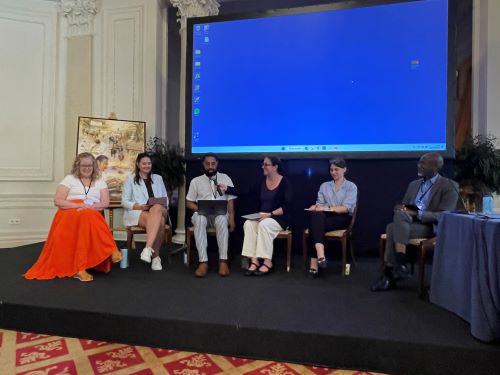
(photo courtesy of Verna Kale, conference co-director)
“Hemingway in Black and White” turned out to be one of the highlights of the 2024 Spain Conference. It was formed following some backlash on the Hemingway Listserv over the appropriate interplay of racial and literary studies, in large part a surprising reaction to a highly scholarly and helpful issue of the Hemingway Review.
Given the key place literary criticism holds within the humanities, literary scholars are particularly called to study what fulfills or limits our being human as those boundaries are explored in a writer’s or thinker’s output, in our case in Hemingway’s creative and critical work.
Most of us born during Hemingway’s life grew up with racist attitudes and assumptions only later to be faced up to and abandoned, or ignored and continued. If we think addressing the topic of race is difficult now, imagine how difficult it was for those writers who, like Hemingway, came before us.
As I heard the teachers, scholars, and writers on the panel—Morgan Lehofer, Margaret Wright-Cleveland, Elena Zolotariov, Ian Marshall, and Lamar Wilson—I was struck once again how interlaced all the besetting “isms” seem to be—the various constructions of race, class, gender, and environment. In particular, the panel discussion highlighted for me how values such as success and ambition, significant elements of what has been understood as the American Dream, play a considerable role in racism’s grip on our minds and hearts.
Those values, appealing alike as they do to those expected and encouraged to rise and those unlikely to rise and thwarted by the institutions around them, sometimes held Hemingway (and others of our “modernist” writers) in their grip. His work, and their work, reflected their authors' sometimes unconscious complicity or, conversely, their growing consciousness.
For Hemingway and some others, there was indeed growth as persons and writers in understanding race and racism. Just for one example, in a very fine article in the Hemingway Review, Ian Marshall followed the inability of the young boy in Hemingway’s “The Porter” to recognize a “revolutionary character” in the black porter who at one point piqued the boy’s interest. But the boy’s inability is revealed by how Hemingway tells the boy’s story: Hemingway’s “older” voice recognized the boy’s inability as a failure, the young boy being drawn at least in part from the young Hemingway looking back and recognizing himself, recognizing his own failure only because, now older, he has come to see clearly what he missed when younger.
In that way “The Porter” is another of Hemingway’s many “confessional” stories like “Snows” and “Hills Like White Elephants,” or novels like A Farewell to Arms, stories where an older voice retells part of the life of his younger self, the narrator always bearing some biographical marks of the author himself.
It pays to learn from people who had to learn to correct themselves, and their own earlier conceptions of life, sometimes even succeeding in at least partially freeing themselves from old -isms. They may not always escape the judgment of our current moral compass, but then it was their work that helped shape the moral compass by which we judge them.
Learning to benefit from the work of writers who fell short of our (or their own) ideals is what African American writer Marilyn Nelson Wanek calls “owning the masters,” a useful concept as our discipline wades into the waters of bringing race studies to bear on our literary values . . . a deep slog that is a must for the future of the Hemingway Society, of all author studies, indeed of the humanities’ place in the academic world.
Charles Peek is emeritus professor of English at the University of Nebraska at Kearney. He is also a poet who won the 2016 Nebraska Book Award for Poetry. He has published on William Faulkner, Willa Cather, and the Harlem Renaissance, as well as Hemingway. He blogs on culture, politics, faith, and other topics at capeek.wordpress.com/